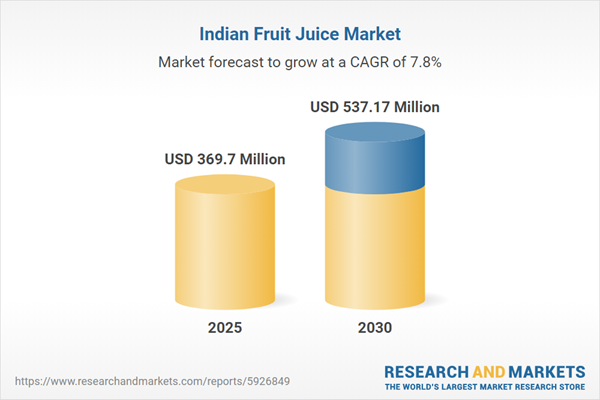Fruit juice refers to the liquid extracted from fruits, typically by pressing or squeezing them. It is a popularbeveragechoice due to its refreshing taste and nutritional content. The growing fruit production and increasing health consciousness in the nation are major growth drivers of the Indian fruit juice market. Moreover, the rapid urbanization rate coupled with increasing disposable income and government initiatives is further expected to propel the Indian fruit juice market.
The Indian fruit juice market is driven by several key factors, including the country's diverse fruit production, rising health consciousness, and increasing disposable income, which have boosted demand for healthier beverage options.
Rapid urbanization, changing consumer lifestyles, and the growing retail presence further contribute to the market's growth. Additionally, government initiatives to support the fruit juice sector, along with infrastructure investments, are strengthening the supply chain and driving market expansion.
Indian fruit juice market drivers
Growing fruit production is propelling the fruit juice market
The diverse climate of India ensures all varieties of fruit production in the nation making it a suitable fruit juice market. For instance, according to the 2021 FAO report, India ranks first in banana (26.45%), mangoes (43.80%), and papayas (39.30%) production and thus contributes significantly to the expanding fruit juice market. According to the APEDA reports, India is ranked second globally in the production of fruits and vegetables. As per the National Horticulture Database, India produced 107.24 million metric tonnes of fruits in 2021-22.Reasons for buying this report:
- Insightful Analysis: Gain detailed market insights covering major as well as emerging geographical regions, focusing on customer segments, government policies and socio-economic factors, consumer preferences, industry verticals, other sub-segments.
- Competitive Landscape: Understand the strategic maneuvers employed by key players globally to understand possible market penetration with the correct strategy.
- Market Drivers & Future Trends: Explore the dynamic factors and pivotal market trends and how they will shape up future market developments.
- Actionable Recommendations: Utilize the insights to exercise strategic decision to uncover new business streams and revenues in a dynamic environment.
- Caters to a Wide Audience: Beneficial and cost-effective for startups, research institutions, consultants, SMEs, and large enterprises.
What do businesses use our reports for?
Industry and Market Insights, Opportunity Assessment, Product Demand Forecasting, Market Entry Strategy, Geographical Expansion, Capital Investment Decisions, Regulatory Framework & Implications, New Product Development, Competitive IntelligenceReport Coverage:
- Historical data & forecasts from 2022 to 2030
- Growth Opportunities, Challenges, Supply Chain Outlook, Regulatory Framework, Customer Behaviour, and Trend Analysis
- Competitive Positioning, Strategies, and Market Share Analysis
- Revenue Growth and Forecast Assessment of segments and regions including countries
- Company Profiling (Strategies, Products, Financial Information, and Key Developments among others)
Indian fruit juice market is analyzed into the following segments:
By Type
- Fruit Drink
- Juice
- Nectar
By Flavor
- Mango
- Apple
- Orange
- Lychee
- Others
By Packaging Formats
- Plastic Bottles
- Tetra Pack
- Cans
By Distribution Channel
- Online
- Offline
By Cities
- Mumbai
- Delhi
- Kolkata
- Bengaluru
- Chennai
- Hyderabad
- Ahmedabad
- Others
Table of Contents
Table Information
| Report Attribute | Details |
|---|---|
| No. of Pages | 90 |
| Published | December 2024 |
| Forecast Period | 2025 - 2030 |
| Estimated Market Value ( USD | $ 369.7 Million |
| Forecasted Market Value ( USD | $ 537.17 Million |
| Compound Annual Growth Rate | 7.7% |
| Regions Covered | India |
| No. of Companies Mentioned | 15 |









